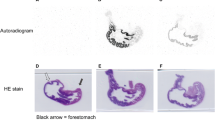Synopsis
The binding of ferric ions to tissue sites, other than those containing sulphated mucosubstances, in sections subjected to the high iron diamine technique was followed by the Prussian blue reaction in order to throw new light on the role of ferric chloride in the high-iron diamine dye bath. From experiments involving enzyme digestions in particular, evidence was obtained that ferric ions bind to ribonucleic acid (in chief cells of the rabbit stomach), deoxyribonucleic acid (in nuclear chromatin granules), and, under certain conditions, to sialic acid residues (e.g. in mucous acini of the mouse sublingual gland) and protein carboxyl groups (in smooth muscle cells) as well.
With a few exceptions, the binding of ferric ions to nucleic acids was not affected by changes in the ferric chloride concentration, pH or magnesium chloride concentration in the dye bath; the bond thus formed was very stable. It is possible that the initial linkage is not an electrostatic one. Under all the conditions investigated, it was found that the diamine complexes have a greater affinity for sulphated mucosubstances than ferric ions, but ferric chloride, by lowering the pH of the dye bath, excludes the carboxyl groups from reacting with the positively-charged diamine polymer molecules. It is possible that a high concentration of ferric ions in the high-iron diamine dye bath inhibits the binding of some diamine complexes to nuclei and gastric chief cells, i.e. sites where no sulphated mucosaccharides are present, although this conclusion needs further substantiation.
Similar content being viewed by others
References
Gad, A. &Sylvén, B. (1969). On the nature of the high iron diamine method for sulfomucins.J. Histochem. Cytochem. 17, 156–60.
Goldstein, B. I., Gerasimova, V. V., Rud, S. G. &Polyakova, L. L. (1966). Further study of DNA fragmentation and its connection with the age of the animal.Ukr. Biokhim. Zunah. 38, 18–26.
Gottschalk, A. (1960). Correlation between composition, structure, shape and function of a salivary mucoprotein.Nature, Lond. 186, 949–51.
Hedström, B. O. A. (1953). Studies on the hydrolysis of metal ions. VII. The hydrolysis of the iron (III) ion, Fe3+.Ark. Kemi 6, 1–16.
Klotz, I. M. (1953). Protein interactions. InProteins. Chemistry, Biological Activity, and Methods. (eds. H. Neurach & K. Bailey, Vol. I, Part B, pp. 727–806. New York: Academic Press.
Kurnick, N. B. (1952). Histological staining with methyl-green-pyronin.Stain Technol. 27, 233–42.
Lillie, R. D. (1954).Histopathologic Technic and Practical Histochemistry, 2nd Edn, p. 34. New York: Blakiston.
Lillie, R. D. (1965).Histopatgologic Technic and Practical Histochemistry, 3rd Edn, p. 407. New York: McGraw-Hill.
Pearse, A. G. E. (1968).Histochemistry. Theoretical and Applied. 3rd Edn, Vol. I, p. 353. London: Churchill.
Rose, P. I. (1971). Protein-Metal ion binding site: Determination with proton magnetic resonance spectroscopy.Science 171, 573–4.
Scott, J. E. &Dorling, J. (1965). Differential staining of acid glycosaminoglycans (mucopolysaccharides) by Alcian blue in salt solutions.Histochemie 5, 221–33.
Sorvari, T. E. (1969). A histochemical study of epithelial mucosubstances in endometrial and cervical adenocarcinomas with reference to normal endometrium and cervical mucosa.Acta path. microbiol. Scand. Suppl.207, 1–85.
Sorvari, T. E. (1972). Binding of ferric ions to nuclei and other tissue sites in sections stained for mucosubstances by the high-iron diamine method.Stain Technol. in press.
Sorvari, T. E. &Sorvari, R.-M. (1969). The specificity of Alcian Blue pH 1.o-Alcian Yellow pH 2.5 staining in the histochemical differentiation of acidic groups in mucosubstances.J. Histochem. Cytochem. 17, 191–3.
Sorvari, T. E. &Näntö, V. (1971). Investigations of dye binding in the sequential staining of mucosaccharides by Alcian Yellow-Alcian Blue. I. Histochemical experiments on different animal and human mucosaccharides.Histochem. J. 3, 261–8.
Spicer, S. S. (1961). The use of various cationic reagents in histochemical differentiation of mucopolysaccharides.Am. J. Clin. Path. 36, 393–407.
Spicer, S. S. (1965). Diamine methods for differentiating mucosubstances histochemically.J. Histochem. Cytochem. 13, 211–34.
Spicer, S. S. &Jarrels, M. H. (1961). Histochemical reaction of an aromatic diamine with acid groups and periodate engendered aldehydes in mucosaccharides.J. Histochem. Cytochem. 9, 368–79.
Spicer, S. S. &Sun, D. C. (1967). Carbohydrate histochemistry of gastric epithelial secretions in dog.Ann. N.Y. Acad. Sci. 140, 762–83.
Wigglesworth, V. B. (1952). The role of iron in histological staining.Quart. J. microsc. Sci. 93, 105–18.
Author information
Authors and Affiliations
Rights and permissions
About this article
Cite this article
Sorvari, T.E. Histochemical observations on the role of ferric chloride in the high-iron diamine technique for localizing sulphated mucosubstances. Histochem J 4, 193–204 (1972). https://doi.org/10.1007/BF01890991
Received:
Issue Date:
DOI: https://doi.org/10.1007/BF01890991




